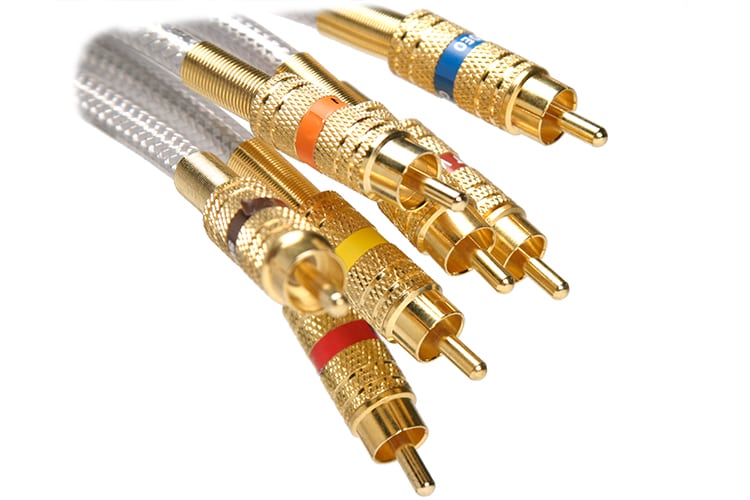RCA surround sound connections can be an excellent way to connect to your home theater speakers if you don’t have digital HDMI or optical options.
They take the basic connection type of our old friend, the analog stereo connection, but use it to power 5.1 or 7.1 surround sound. This article looks at analog RCA surround sound connections in detail and explains when you would use them.
Main Topics
What Does a Surround Sound RCA Connection Do?
A surround sound RCA connection sends multichannel analog audio signals – for example, a surround soundtrack on a DVD or Blu-ray.
It does not support digital audio signals but is an alternative to the more common ways of sending multichannel audio – HDMI, optical or coaxial.
Some high-end Blu-ray players have multiple RCA audio connections on the back for surround sound setups. Typically, there will be connections for front left and right speakers, surround left and right speakers, center channel speaker, and subwoofer.
The front left and right RCA connections are red and white and send the main stereo audio. The surround left and right RCA connections are often red and white (not always) and carry the rear surround channel audio.
The center RCA connection is often green or blue and carries the dialog/center channel audio. The subwoofer RCA connection is usually purple or black for the low-frequency effects (LFE) channel.
To set up a surround system using multichannel RCA analog audio, run RCA cables from the Blu-ray player to an AV receiver or directly to powered speakers. The AV receiver or powered speakers amplify the signals and send them to the correct speakers around the room.
What Does a Multichannel RCA Connection Look Like?
RCA surround sound connectors on the back of your device will look something like this.

This picture is a typical example from the back of a Blu-ray or DVD player – although not all players will have these.
There are six RCA jacks for each of the 5.1 surround sound connections:
- Front left
- Front right
- Center
- Rear left (surround)
- Rear right (surround)
- Subwoofer
On some devices, you may find more connections than this for speaker layouts with more channels – like 6.1 or 7.1 configurations.
In the example above, you can also see two extra connections on the right for a separate analog stereo audio output.
What Does a Surround Sound RCA Cable Look Like?

You don’t need a special cable to connect to a device with an analog multichannel output. You use standard analog RCA to RCA cables.
For instance, you could use three stereo RCA interconnect cables to make the connections – or six individual ones.
Just make sure you connect the same jacks between the player (output) and the amplifier (input):
- Front right output to the front right input
- Center output to the center input
- Front left output to the front left input
And so on. Otherwise, you’ll get yourself in a right mess.
When Should You Use RCA Surround Sound Connections?
In most cases, if you want to send multichannel audio to an AV receiver or amplifier, use a digital audio connection such as an HDMI connector, optical digital audio or coaxial digital audio.
| Connection Type | Audio Quality | Cable Design | Audio Channels |
|---|---|---|---|
| Multichannel RCA (Analog) | Good (excellent in high-end devices) | Simple, color-coded for easy identification | Mostly 6 channels, but more in supported devices |
| HDMI (Digital) | Excellent | More complex, not easily user-serviceable | Up to 32 channels (surround sound systems) |
| Optical/TOSLINK (Digital) | Very Good | Bends easily and can be delicate, uses light to transmit data, not easily user-serviceable | Up to 6 channels (surround sound systems) |
| Coaxial (Digital) | Very Good | Durable, thick shielding to prevent signal loss | Up to 6 channels (surround sound systems) |
However, what if your DVD/Blu-ray player or amplifier lacks digital audio connections?
In this case, you could still play surround sound in your room if your player and amplifier both had analog multichannel jacks.
In some circumstances, you may also need to use analog multichannel outputs from a DVD/Blu-ray player to hear some types of multichannel audio such as SACD, Dolby TrueHD and DTS-HD Master Audio.
If your AV receiver doesn’t decode a format like Dolby TrueHD, you could let your player decode the audio first and send the uncompressed audio via the analog outputs.
Unfortunately, finding audio-visual components with analog multichannel outputs is becoming harder as more devices have digital audio connections.
However, an analog multichannel connection can lengthen the lifespan of older devices by removing the reliance on digital interfaces.
While a digital audio connection has many good things going for it, the copy-protection in some of these digital audio signals isn’t one of them!
In this case, analog multichannel devices are handy.
If your DVD/Blu-ray player can decode the digital audio onboard, you can hear this audio from the analog outputs without worrying about having a compatible digital amplifier.
You just make an analog connection using the ports shown above.
So this connection type can enable you to hear SACD, DVD-A, DTS-HD Master Audio and Dolby TrueHD soundtracks without spending extra money upgrading all your equipment.
About The Author
Paul started the Home Cinema Guide to help less-experienced users get the most out of today's audio-visual technology. He has been a sound, lighting and audio-visual engineer for around 20 years. At home, he has spent more time than is probably healthy installing, configuring, testing, de-rigging, fixing, tweaking, re-installing again (and sometimes using) various pieces of hi-fi and home cinema equipment. You can find out more here.




